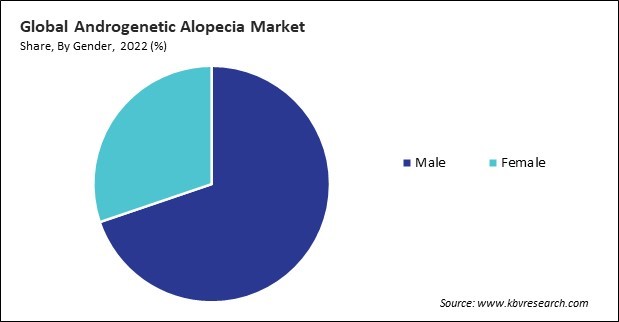“Global Androgenetic Alopecia Market to reach a market value of USD 4.6 Billion by 2030 growing at a CAGR of 8.1%”
The Global Androgenetic Alopecia Market size is expected to reach $4.6 billion by 2030, rising at a market growth of 8.1% CAGR during the forecast period.
Advancements in pharmaceutical R&D led to the discovery and development of innovative drugs for androgenetic alopecia. Therefore, the pharmaceuticals segment acquired $2,429.0 million revenue in 2022. New formulations and mechanisms of action expand the range of pharmaceutical options available to patients.

Cosmetic solutions are non-invasive and easy to use. Individuals can apply these products themselves, making them a convenient and user-friendly option for those who prefer non-surgical and non-pharmaceutical interventions. Thus, because of the increasing demand for cosmetic solutions, the market is anticipated to increase significantly.
Additionally, Androgenetic alopecia is more common in older age groups. The physiological changes associated with aging, such as hormonal shifts and reduced hair follicle function, contribute to a higher incidence of hair loss in the aging population. Hence, increasing number of senior citizens has been a pivotal factor in driving the growth of the market.
The market may experience disruptions in the supply chain, affecting the availability of pharmaceuticals, surgical instruments, and other related products. Delays in manufacturing and distribution can impact the delivery of treatments and interventions. Non-invasive and at-home solutions gained popularity. Thus, the COVID-19 pandemic had a moderate effect on the market.
However, High treatment costs may limit access to effective interventions, particularly for individuals with lower socioeconomic status or those without comprehensive health insurance coverage. This limited accessibility can result in a significant portion of the population being unable to afford advanced treatments. Thus, the high costs of some treatment options can slow down the growth of the market.
Based on treatment, the market is classified into pharmaceuticals and devices. The devices segment acquired a 3% revenue share in the market in 2022. The availability of devices for home use has expanded the reach of treatments. Home-use devices, such as laser caps and helmets, provide convenience for individuals seeking to address androgenetic alopecia in the comfort of their homes.
By gender, the market is categorized into male and female. In 2022, the male segment acquired 70% revenue share in the market. Androgenetic alopecia is more prevalent in men than in women. As a result, men experiencing androgenetic alopecia may be more motivated to seek interventions to address hair loss, contributing to the uplift of the male segment in the market.

By sales channel, the market is segmented into prescriptions and OTC. The OTC segment recorded a remarkable 34% share in the market in 2022. The OTC segment offers a variety of products, including topical treatments, shampoos, supplements, and cosmetic solutions, providing consumers with diverse options to address their specific needs and preferences.
On the basis of end-use, the market is divided into dermatology clinics and homecare settings. In 2022, the dermatology clinics segment dominated the market with 62.4% revenue share. These diagnostic tools help dermatologists accurately assess the severity and nature of androgenetic alopecia, guiding them in developing personalized treatment plans.
Free Valuable Insights: Global Androgenetic Alopecia Market size to reach USD 4.6 Billion by 2030
Region-wise, the market is analysed across North America, Europe, Asia Pacific, and LAMEA. In 2022, the North America region led the market by generating the 38.2% revenue share. In North America, individuals may start noticing hair loss in their 20s or 30s, increasing the risk.
| Report Attribute | Details |
|---|---|
| Market size value in 2022 | USD 2.5 Billion |
| Market size forecast in 2030 | USD 4.6 Billion |
| Base Year | 2022 |
| Historical Period | 2019 to 2021 |
| Forecast Period | 2023 to 2030 |
| Revenue Growth Rate | CAGR of 8.1% from 2023 to 2030 |
| Number of Pages | 240 |
| Number of Tables | 400 |
| Report coverage | Market Trends, Revenue Estimation and Forecast, Segmentation Analysis, Regional and Country Breakdown, Porter’s 5 Forces Analysis, Company Profiling, Companies Strategic Developments, SWOT Analysis, Winning Imperatives |
| Segments covered | Treatment, Gender, Sales Channel, End-use, Region |
| Country scope |
|
| Companies Included | Cipla Limited, Merck & Co., Inc., GlaxoSmithKline PLC (GSK)Sun Pharmaceuticals Industries Ltd., Dr. Reddy’s Laboratories Ltd., Aurobindo Pharma Limited, Pfizer, Inc., Lutronic Co., Ltd., Viatris Inc., Eli Lilly and Company |
By Treatment
By Gender
By Sales Channel
By End-use
By Geography
This Market size is expected to reach $4.6 billion by 2030.
Advancements in research and development (R&D) are driving the Market in coming years, however, High costs of some treatment options restraints the growth of the Market.
Cipla Limited, Merck & Co., Inc., GlaxoSmithKline PLC (GSK)Sun Pharmaceuticals Industries Ltd., Dr. Reddy’s Laboratories Ltd., Aurobindo Pharma Limited, Pfizer, Inc., Lutronic Co., Ltd., Viatris Inc., Eli Lilly and Company
The expected CAGR of this Market is 8.1% from 2023 to 2030.
The Prescriptions segment is generating the highest revenue in the Market, By Sales Channel in 2022; there by, achieving a market value of $2.9 Billion by 2030.
The North America region dominated the Market, By Region in 2022, and would continue to be a dominant market till 2030; there by, achieving a market value of $1.6 Billion by 2030.
Our team of dedicated experts can provide you with attractive expansion opportunities for your business.

 Drivers
Drivers
 Restraints
Restraints
 Opportunities
Opportunities
 Challenges
Challenges
